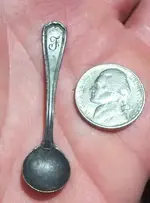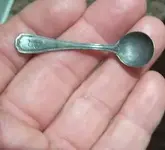thrillathahunt
Silver Member
TC and me detected an old Victorian era house today and I found this very tiny sterling silver spoon. Albert thinks it's an old medicine spoon. It's only 2" long, and marked STERLING with a lion hallmark on the back. Any ideas?
Isn't it cute?
Isn't it cute?









 but maybe it is made for little people with little hands
but maybe it is made for little people with little hands 

